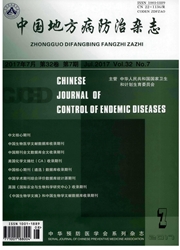

 中文摘要:
中文摘要:
目的探讨碘缺乏和碘过量对子代小鼠海马CA1区神经胶质细胞的影响。方法断乳后1个月Balb/C小鼠,雌雄各半,随机分为5组:低碘组(LI),适碘组(NI),5倍碘组(5HI),10倍碘组(10HI),50倍碘(50HI),给予不同浓度的碘化钾碘水,饲养3个月后雌雄合笼,取子代小鼠20日龄、40日龄脑组织,应用免疫组织化学技术观察海马CA1区放射层及腔隙分子层神经胶质细胞,并进行形态计量学分析。结果不同日龄小鼠与NI组相比,5HI组、10HI组面数密度及平均光密度无明显差别,且无统计学意义;LI组、50HI组面数密度及平均光密度有不同程度的下降,且有统计学意义。结论脑发育临界期碘缺乏及严重碘过量会影响子代小鼠海马神经胶质细胞的发育,且碘缺乏的影响较碘过量严重。
 英文摘要:
英文摘要:
Objective To study the relationship between different iodine intake and the development of cerebral hippocampal GFAP glial cells in filial generation of Balb/c mice. Methods The mice were divided into five groups( LI, NI, 5HI, 10HI, 50HI) by drinking water with different iodine concentrations. After three months, the mice mated and their first filial generations of 20 - day and 40 - day were observed. The expression of GFAP were examined by immunohistochemistry, the numerical density on area and the average of optical density were measured. Results Compared with the NI group, the numerical density on area and average optical of 5HI, 10HI groups were indiscriminate, but LI, 50HI groups were descent, and they have statistical significance. Conclusions Both iodine deficiency and iodine excess can affect the the development of cerebral hippocampal GFAP glial cells. However, iodine deficiency plays more important role in the development of glial cell rather than iodine excess.
 同期刊论文项目
同期刊论文项目
 同项目期刊论文
同项目期刊论文
 期刊信息
期刊信息
